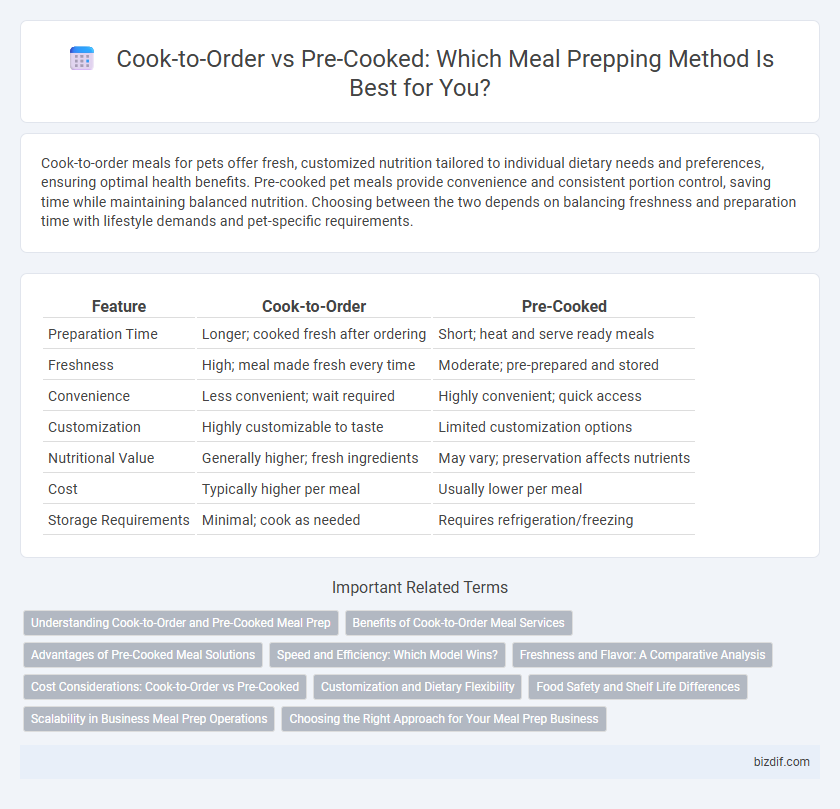Cook-to-order meals for pets offer fresh, customized nutrition tailored to individual dietary needs and preferences, ensuring optimal health benefits. Pre-cooked pet meals provide convenience and consistent portion control, saving time while maintaining balanced nutrition. Choosing between the two depends on balancing freshness and preparation time with lifestyle demands and pet-specific requirements.
Table of Comparison
| Feature | Cook-to-Order | Pre-Cooked |
|---|---|---|
| Preparation Time | Longer; cooked fresh after ordering | Short; heat and serve ready meals |
| Freshness | High; meal made fresh every time | Moderate; pre-prepared and stored |
| Convenience | Less convenient; wait required | Highly convenient; quick access |
| Customization | Highly customizable to taste | Limited customization options |
| Nutritional Value | Generally higher; fresh ingredients | May vary; preservation affects nutrients |
| Cost | Typically higher per meal | Usually lower per meal |
| Storage Requirements | Minimal; cook as needed | Requires refrigeration/freezing |
Understanding Cook-to-Order and Pre-Cooked Meal Prep
Cook-to-order meal prep involves preparing dishes fresh upon request, ensuring optimal flavor and customization tailored to individual preferences. Pre-cooked meal prep focuses on batch cooking meals in advance, offering convenience and time savings by simply reheating portions as needed. Both methods cater to different lifestyle needs, with cook-to-order emphasizing freshness and pre-cooked prioritizing efficiency and storage longevity.
Benefits of Cook-to-Order Meal Services
Cook-to-order meal services offer the advantage of freshly prepared dishes tailored to individual dietary preferences and portion sizes, ensuring optimal flavor and nutritional value. These services reduce food waste by cooking only what is needed at the moment of order, enhancing sustainability and cost-efficiency. Customers benefit from customizable menus, allowing for greater dietary control and the inclusion of fresh, high-quality ingredients.
Advantages of Pre-Cooked Meal Solutions
Pre-cooked meal solutions offer significant time savings by eliminating the need for daily cooking, allowing for quick and convenient meal access. They provide consistent portion control and nutritional content, which supports effective dietary management. These meals also reduce food waste through precise meal planning and extended shelf life.
Speed and Efficiency: Which Model Wins?
Cook-to-order meal prepping ensures freshness and customization but often requires longer preparation and wait times, reducing overall speed and efficiency in high-demand settings. Pre-cooked meals, on the other hand, significantly cut down service time by offering instant availability and streamlined portioning, optimizing operational efficiency. For those prioritizing rapid meal delivery and consistent output, the pre-cooked model typically outperforms cook-to-order.
Freshness and Flavor: A Comparative Analysis
Cook-to-order meals retain maximum freshness and flavor as they are prepared immediately upon request, ensuring ingredients are vibrant and textures are optimal. Pre-cooked meals, while convenient for time-saving, often experience diminished taste and nutrient loss due to storage and reheating processes. Evaluating freshness and flavor highlights cook-to-order as the superior method for a more satisfying and nutritious meal prepping experience.
Cost Considerations: Cook-to-Order vs Pre-Cooked
Cook-to-order meal prepping often incurs higher labor costs due to individualized preparation and longer cooking times, impacting overall expenses. Pre-cooked meals benefit from economies of scale, lowering per-unit production costs and reducing waste through bulk preparation. Choosing between these options depends on budget constraints and the value placed on customization versus convenience.
Customization and Dietary Flexibility
Cook-to-order meal prepping offers maximum customization, allowing individuals to tailor ingredients and portion sizes to meet specific dietary needs such as keto, vegan, or allergen-free options. Pre-cooked meals provide convenience but often lack flexibility, as they are prepared in bulk with standardized recipes that may not accommodate individual dietary restrictions or preferences. Choosing cook-to-order services enhances dietary flexibility by enabling real-time adjustments based on nutritional goals and personal taste.
Food Safety and Shelf Life Differences
Cook-to-order meals minimize food safety risks by being prepared fresh, reducing the chance of bacterial growth that can occur during storage. Pre-cooked meals offer convenience but require strict refrigeration and reheating protocols to prevent contamination and maintain safe consumption within their shorter shelf life. Understanding these differences is crucial for effective meal prepping, ensuring both safety and quality.
Scalability in Business Meal Prep Operations
Cook-to-order meal prep models offer customization but often face scalability challenges due to longer preparation times and increased labor demands. Pre-cooked meal systems optimize scalability by streamlining food production, reducing cook times, and enabling bulk cooking processes. Businesses adopting pre-cooked strategies can efficiently handle larger customer volumes and maintain consistent quality while minimizing operational costs.
Choosing the Right Approach for Your Meal Prep Business
Selecting the ideal meal prep strategy hinges on your target market's demand for freshness versus convenience. Cook-to-order ensures maximum freshness and customization, attracting health-conscious consumers willing to wait, while pre-cooked meals offer speedy service and extended shelf life, ideal for high-volume operations. Balancing preparation time, ingredient quality, and customer preference is crucial to optimizing profit margins and operational efficiency.
Cook-to-Order vs Pre-Cooked Infographic

 bizdif.com
bizdif.com